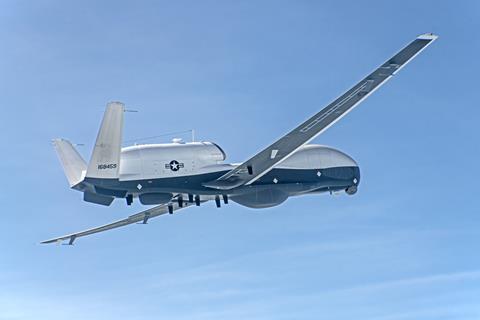When a Northrop Grumman MQ-4C Triton touched down at NAS Sigonella in Sicily, Italy on 30 March, it marked the second overseas deployment of the US Navy’s new intelligence-gathering drone, a type declared operational in July 2023.
But even amid that deployment, navy brass back home were proposing plans to halt MQ-4C production early, raising questions about what role the type – which has suffered early troubles with its intelligence-gathering technologies – will play in the navy’s future.

The deployment occurred shortly after the service’s fiscal year 2025 budget request was released. The request included funding dedicated to shutting down the Triton production line and delivering the last MQ-4C in October 2028. Budget documents show that the final MQ-4C delivery will give the navy an inventory of 27 Tritons.
That is 48 fewer than originally planned when the Triton programme commenced in 2008. The decision to sharply curtail the initially planned buy of 70 MQ-4Cs was announced in 2022, the result of a re-evaluation of worldwide intelligence, surveillance and reconnaissance (ISR) and targeting needs by the Pentagon’s Joint Requirements Oversight Council (JROC).
The Triton deployed to Sigonella is part of Unmanned Patrol Squadron 19 (VUP-19), the navy’s sole MQ-4C squadron. The aircraft is one of nine examples delivered to the navy so far, according to the US Naval Air Systems Command (NAVAIR).
Derived from the RQ-4 Global Hawk flown by the US Air Force, the more-capable MQ-4C is a high-altitude, long-endurance uncrewed air vehicle optimised for overwater missions. NAVAIR’s Persistent Maritime Unmanned Aircraft Systems Programme Office (PMA-262) is responsible for developing, producing, fielding and sustaining MQ-4Cs.
The programme office did not respond to questions about the JROC’s decision to cut the MQ-4C fleet. Nor did it answer questions about how the much-smaller force of Tritons will keep up with high demand from US military combatant commanders and from navy fleet commanders for the signals intelligence, geospatial intelligence and sea-surface surveillance and reconnaissance the platform is meant to provide.
PMA-262 also did not respond to questions about the latest report from the Pentagon’s Director of Operational Test and Evaluation (DOT&E) about the MQ-4C. The document says the Triton did not enter its required initial operational test and evaluation phase in FY2023 due to “immature systems that precluded operationally representative testing for the primary missions”.
“Immature systems” refers to the Triton’s signals-intelligence sensors, which the DOT&E says have deficiencies that “precluded a stable configuration and operationally realistic testing”.
The report also notes that the navy does not have a method to extract “all types of data” from the Minotaur mission-management system, which operators use to control MQ-4C sensors, view sensor data and build operating pictures. The report further states that the operational effectiveness of the MQ-4C for its primary signals-intelligence mission is “unknown”.
Despite that, MQ-4Cs are now flying operational missions.
As originally envisioned, MQ-4Cs were to be paired with the navy’s manned Boeing P-8A Poseidon multi-mission maritime patrol aircraft. They were to replace the navy’s ageing Lockheed Martin EP-3E Aries II multi-intelligence aircraft (developed from the P-3C Orion), now operated for signals-intelligence and ISR missions by Fleet Air Reconnaissance Squadron 1.
NAVAIR’s website says the navy still has 10 EP-3Es in service. The service has plans to retire the type in 2025 before a second Triton squadron, VUP-11, is to be established in FY2026.
Another VUP-19 detachment out of Andersen AFB in Guam is also flying MQ-4Cs, in support of the navy’s Seventh Fleet in the Indo-Pacific region.
NAVAIR confirms Australia still plans to buy four MQ-4Cs for operation with the Royal Australian Air Force (RAAF). Northrop last November completed first flight of the first MQ-4C destined for Australia, and says the RAAF will receive its first MQ-4C this year.
Story updated on 9 April, following clarification from the USN, to note that it intends to acquire 27, not 22, Tritons.



























